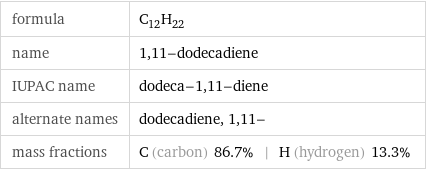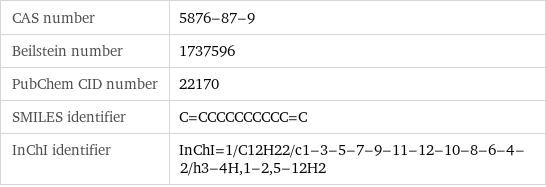Input interpretation

1, 11-dodecadiene
Chemical names and formulas

formula | C_12H_22 name | 1, 11-dodecadiene IUPAC name | dodeca-1, 11-diene alternate names | dodecadiene, 1, 11- mass fractions | C (carbon) 86.7% | H (hydrogen) 13.3%
Lewis structure

Draw the Lewis structure of 1, 11-dodecadiene. Start by drawing the overall structure of the molecule, ignoring potential double and triple bonds: Count the total valence electrons of the carbon (n_C, val = 4) and hydrogen (n_H, val = 1) atoms: 12 n_C, val + 22 n_H, val = 70 Calculate the number of electrons needed to completely fill the valence shells for carbon (n_C, full = 8) and hydrogen (n_H, full = 2): 12 n_C, full + 22 n_H, full = 140 Subtracting these two numbers shows that 140 - 70 = 70 bonding electrons are needed. Each bond has two electrons, so in addition to the 33 bonds already present in the diagram add 2 bonds. To minimize formal charge carbon wants 4 bonds. Identify the atoms that want additional bonds and the number of electrons remaining on each atom: Fill in the 2 bonds by pairing electrons between adjacent highlighted atoms: Answer: | |
3D structure

3D structure
Basic properties

molar mass | 166.31 g/mol phase | liquid (at STP) boiling point | 208.5 °C density | 0.7702 g/cm^3 solubility in water | insoluble
Units

Liquid properties (at STP)

density | 0.7702 g/cm^3 refractive index | 1.44
Units

Chemical identifiers

CAS number | 5876-87-9 Beilstein number | 1737596 PubChem CID number | 22170 SMILES identifier | C=CCCCCCCCCC=C InChI identifier | InChI=1/C12H22/c1-3-5-7-9-11-12-10-8-6-4-2/h3-4H, 1-2, 5-12H2